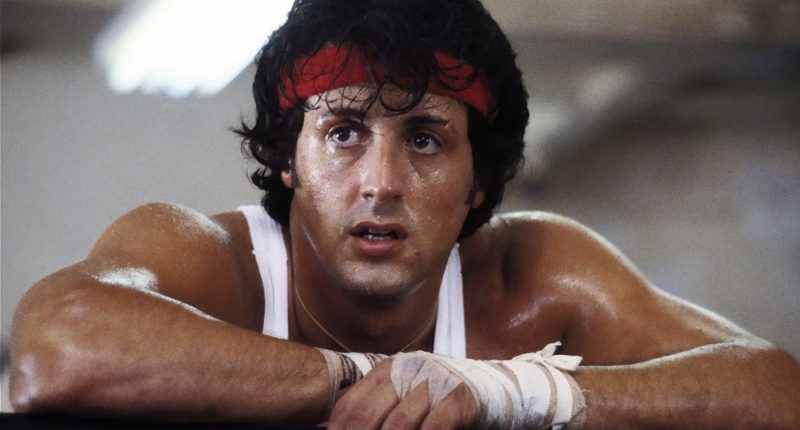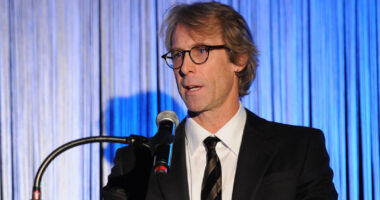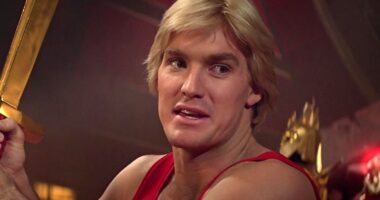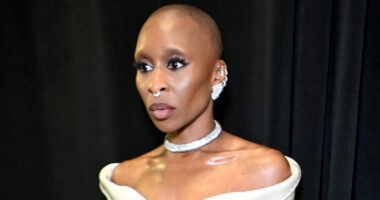Share this @internewscast.com
Few types of films ignite an audience’s enthusiasm quite like sports movies. Observing an individual or a team collaborate to accomplish a seemingly unreachable physical aim is captivating and irresistible. Although numerous boxing films exist, many rooted in true tales, none quite compare to the iconic “Rocky” series. Created by Sylvester Stallone, who drafted the script on his own with the condition that he would also play the lead role, the original “Rocky” became a massive success, leading to a collection of both direct sequels and newer installments. This invites the question: What is the optimal sequence for watching these compelling sports dramas?
Sometimes, simpler is better, and that’s absolutely the case here with the “Rocky” series. Starting with the 1976 original and then working your way to the present from there is the best way to go. This includes all six “Rocky” films as well as the franchise’s legacy sequel “Creed” and its sequels. Whether you’re a longtime fan of Stallone’s “Rocky” films or a newcomer who jumped on the “Creed” bandwagon and now wants to dive into the original series, be sure to watch this franchise in the order that follows:
- “Rocky” (1976)
- “Rocky II” (1979)
- “Rocky III” (1982)
- “Rocky IV” (1985)
- “Rocky V” (1990)
- “Rocky Balboa” (2006)
- “Creed” (2015)
- “Creed II” (2018)
- “Creed III” (2023)
With this order in mind, let’s dive into why the “Rocky” franchise is best viewed in chronological order.
Why is that the correct order to watch the Rocky movies?
When watching a movie franchise, it’s almost always best to start with the first project released. This allows you to experience the film series the way the initial audience did with a film that’s generally more accessible to new audiences. This is the case with 1976’s “Rocky.” The picture is a rags-to-riches story about a Mafia loan shark collector who leaves that life behind to step into the ring as a professional boxer. Without the foundation of Rocky’s time as a club fighter, his romance with Adrian (Talia Shire), and the rivalry between himself and Apollo Creed (Carl Weathers), the rest of the franchise won’t mean a thing to you.
For a few years in the ’70s and ’80s, a new “Rocky” flick was coming out every couple of years. Because of this, we watch Rocky grow to his absolute peak as he pursues the American Dream. Over the course of five individual pictures, the films chronicle the fullness of his initial boxing career. It’s hard to watch that out of order without feeling cheated in some way. Following up 1990’s “Rocky V” with “Rocky Balboa” (released 16 years later) provides a far more satisfying conclusion to the original saga, acting as a compelling epilogue and send-off to his boxing career.
Considering that “Creed” and its sequels are technically all legacy sequels, they’re made in a way where you could watch them apart from the “Rocky” films. The problem is — and this is especially true of “Creed II” — there is so much Rocky Balboa and Apollo Creed backstory that becomes crucial to the emotional weight of Rocky’s arc in the “Creed” movies. Because of this, it’s best to just stick with the chronological order.
Rocky (1976)
You can’t really watch the “Rocky” movies without first starting with “Rocky.” Not only is the 1976 boxing flick a classic underdog story in a narrative sense, but getting this independent picture made in the first place was quite a feat. One little-known fact about Sylvester Stallone is that he wrote “Rocky” with himself in mind from the very beginning, and although the film could have been made by various outlets, his refusal to give up the project without playing the main part shoved it into the arms of producers Irwin Winkler and Robert Chartoff. In the end, “Rocky” was a major hit, and the film’s distribution partners (United Artists) couldn’t have been happier. Even with the controversial bittersweet ending, “Rocky” remains a true triumph of the human spirit, both on-screen and behind the scenes.
Starting with “Rocky” is paramount because it’s here that all the groundwork is laid for the rest of the series. Not only does Rocky Balboa rise to fame as Philly’s everyman boxer, but the film also establishes his relationship with his trainer Mickey Goldmill (Burgess Meredith), his fierce competition with Apollo Creed, and what it truly means to go the distance. Of course, Rocky’s friendship with Paulie Pennino (Burt Young) and his eventual romance with Paulie’s sister Adrian are a major part of the story as well. With all the pieces set and the vast Philadelphia iconography firmly in place, the door is opened to the rest of the franchise.
Rocky II (1979)
Picking up right where “Rocky” ends, the first sequel, “Rocky II,” is the film that truly establishes the Italian Stallion as a champion in the ring. Although Rocky at first desires to leave the professional boxing world behind, Apollo Creed successfully pulls him back in for a rematch. While Rocky didn’t win against Apollo, he got closer than any other to taking the heavyweight title from him, and the champion is nervous about what that may mean. As Apollo struggles with this, Rocky and Adrian marry and start their new life together before the boxer ultimately returns to the ring. The result is a fight as impressive as the first, as Rocky and Apollo both give their all before “Rocky II” concludes a bit more triumphantly than the original.
While John G. Avildsen directed the first film (and would later helm the original “Karate Kid” trilogy), “Rocky II” was the first installment directed by Sylvester Stallone himself. Here, Stallone establishes all the things that happen in every “Rocky” movie and crafts a sequel entirely worthy of the original. Whether you prefer the original “Rocky” or “Rocky II,” there’s no denying that each film feels like half of the bigger whole. With a larger production budget, “Rocky II” looks more impressive visually than the original, and Stallone’s vision for the franchise can be seen clearly in his directorial style.
Rocky III (1982)
Taking place five years after Rocky’s win at the end of “Rocky II,” Sylvester Stallone returns as director, screenwriter, and star for “Rocky III.” Over the years, Rocky has faithfully defended his heavyweight title and continues to prove himself as a boxer. Because of this, he’s a bit richer (and certainly more famous) than before, meaning that he has a lot more to lose. This is, of course, when newcomer Clubber Lang (Mr. T) challenges our hero. It turns out that Mickey had been scheduling matches for Rocky where he knew the Italian Stallion would come out on top, fearful that another beating (like the one he received from Apollo Creed) would end him. But when Rocky faces Lang, things don’t go his way, and the hero is forced to start over again to restore his honor and glory.
“Rocky III” is great. It returns the series to its roots and forces Rocky to confront his own mortality for the first time. Between the death of a loved one and the apparent end of his boxing career, Rocky goes to the one man who can help him overcome his challenges: Apollo Creed. “Rocky III” is a pivotal chapter in the entire “Rocky” story that is satisfying every time. Plus, that rematch between Rocky and Lang at the end is arguably the greatest fight in the franchise — a powerhouse clobbering session with the highest stakes imaginable for our hero. It’s no wonder the third entry (which boasted Survivor’s “Eye of the Tiger” as its theme song) outgrossed both previous installments.
Rocky IV (1985)
Outside of the original, perhaps no “Rocky” film is as well-known or beloved as “Rocky IV.” Released smack in the middle of a decade full of Cold War-era fears about nuclear war, “Rocky IV” is a bizarre but powerful product of its time. Directed again by Stallone, the film brought Apollo Creed back into the ring to defend his nation against the Soviet boxer Ivan Drago (Dolph Lundgren). After Drago challenges America in hopes of proving that Russian men come from a different stock, Creed is shockingly killed by the Siberian Express in the ring. Hoping to avenge both his friend and his country, Rocky travels to the Soviet Union to face Drago himself, resulting in a trading of impossible blows. Full of both patriotism and a call to global unity, “Rocky IV” was quite timely in its day and feels just as relevant now.
Featuring some of the most memorable fights in the franchise, as well as Rocky’s best training sequence in the wintry Russian landscape, “Rocky IV” is a great time. Of course, it also dates itself as an ’80s movie, and not just because of the Cold War politics. In fact, one of the biggest unanswered questions in the “Rocky” franchise comes directly from this film: Whatever happened to Paulie’s robot? Yes, oddly enough, there is a robot in this movie, and it’s never seen or heard from again. For longtime “Rocky IV” fans, “Rocky IV: Rocky vs. Drago — The Ultimate Director’s Cut” is probably the way to go — and yes, it removes the robot entirely.
Rocky V (1990)
After years away from the film series, director John G. Avildsen returned in 1990 for “Rocky V,” again written by Stallone. The film takes place after Rocky’s battle with Drago, which resulted in further medical complications that force Balboa into early retirement. Unfortunately, Rocky and his family lose their entire fortune after Paulie makes a bad deal with their attorney, sending them back to their old Philly neighborhood. There, Rocky takes over Mickey’s old gym and begins to train new up-and-coming boxers, namely an Oklahoma boy named Tommy Gunn (real-life boxer Tommy Morrison).
What seems like a great idea at first quickly turns sour, however, as Rocky begins to neglect his son Robert (Sage Stallone). Even worse, Gunn becomes so enamored by the fame and fortune of boxing that he not only turns on Rocky but also becomes actively hostile, leading to a memorable street brawl to settle the score.
If there’s one “Rocky” movie that Sylvester Stallone hates, it would be “Rocky V” — and he’s certainly not alone. The film does not live up to the hefty standards of the initial “Rocky” sequels and, frankly, is not anywhere near as enjoyable a watch. It’s no wonder that Stallone took a long break in between making “Rocky V” and the next installment, released over 15 years later. While there are a lot of narrative threads here that pull from previous films, “Rocky V” (just like Tommy Gunn himself) lacks the heart that made the other movies so endearing.
Rocky Balboa (2006)
Returning to the director’s chair for the first time since “Rocky IV,” Sylvester Stallone returns for one last fight in 2006’s “Rocky Balboa.” Desiring to end the “Rocky” franchise on a more hopeful note that felt more in step with the rest of the series, Stallone fought for over a decade to get “Rocky Balboa” made. Part legacy sequel, part franchise send-off, Rocky is now much older. Having lost Adrian to cancer a few years prior and struggling to connect with his son Robert (now played by Milo Ventimiglia), Rocky suddenly finds himself renewing his boxing license and accepting a challenge from current heavyweight champ Mason “The Line” Dixon (former light heavyweight boxing champ Antonio Tarver). Echoing the original 1976 film, Rocky goes the distance with Dixon, which is all that counts for him in the end.
“Rocky Balboa” is a far better send-off for Rocky and his supporting cast than “Rocky V.” It’s a grand story about legacy and honor that ultimately feels most in line with the weight of Stallone’s original film. Easily one of the most memorable legacy sequels to date, “Rocky Balboa” is a triumphant end to Rocky’s six-picture story. Although, even this movie isn’t really the end of Stallone’s time with the character or the franchise.
Creed (2015)
In 2015, director Ryan Coogler revived the “Rocky” franchise through “Creed,” a spin-off that doubles as a legacy sequel. Rather than featuring Rocky as the leading man, “Creed” pivots to young Adonis “Donnie” Johnson (Michael B. Jordan), an up-and-coming boxer who doubles as the illegitimate son of Apollo Creed. Unfortunately, Adonis never got the chance to know his father, and so he instead seeks to follow in his footsteps as a fighter. But he can’t get there without a champion to train him. This takes Adonis from Los Angeles to Philadelphia to recruit Rocky to his cause. Though hesitant at first, Rocky agrees, and Adonis rises up in the ranks in a fashion quite similar to the original “Rocky.” Along the way, he meets and falls in love with Bianca Taylor (Tessa Thompson), our new hero’s own “Adrian.”
As the first franchise installment not penned by Stallone, “Creed” certainly delivers on its promise. Though Rocky is not the focus of the film, he takes on a role here not unlike his old mentor Mickey, and there’s something quite serendipitous about that. “Creed” blew the minds of longtime “Rocky” fans and newcomers right out of the gate and more than delivered on its promise. So, it was no surprise when “Creed” grew beyond a single installment, and Rocky came with it.
Creed II (2018)
After the success of “Creed,” it wasn’t surprising that “Creed II” hit theaters only a few years later. What was a bit surprising, however, is that Ryan Coogler did not return to the director’s chair, prompting Steven Caple Jr. to take over. Additionally, Sylvester Stallone is more than a star and producer this time around. He also came back to write this sequel (alongside Juel Taylor), which doubles as a legacy continuation of the longtime fan-favorite “Rocky IV.” Yes, “Creed II” is certainly a sequel to the first “Creed,” but it also works in plot threads that call back directly to the Cold War, pitting Adonis Creed against Viktor Drago (Florian Munteanu), the son of the man who killed his father in the ring. For “Rocky” fans, this match-up was a long time coming, bringing a fuller conclusion to the Creed/Drago rivalry.
What’s more is that “Creed II” is the last time that Sylvester Stallone has appeared in the “Rocky” franchise. The film ends with Rocky making amends with his son Robert as Adonis makes peace with the memory of the father he never knew. In many ways, “Creed II” feels like the end of the franchise, but it also sparks a new beginning for Adonis Creed. This may be Rocky’s franchise send-off, but there’s still one more film on the list.
Creed III (2023)
In his directorial debut, Michael B. Jordan follows in Sylvester Stallone’s footsteps by directing “Creed III” himself. Though Stallone is still credited as a producer here (and Rocky is mentioned), “Creed III” moves Adonis, Bianca, and their daughter Amara (Mila Davis-Kent) from one coast to another. Settling in Los Angeles, Adonis gets back in touch with his roots, including his former childhood friend, Damian Anderson (Jonathan Majors), who begs Donnie for a chance against him in the ring. Adonis agrees, but the whole thing ends poorly as “Diamond Dame” Anderson ends up becoming the next champion. Adonis and Dame are forced to confront their shared traumatic past as they deal with their issues in the ring.
Of all the small details you may have missed in “Creed III,” the most important is that, even without Rocky in his corner, Adonis has taken his mentor’s lessons to heart. He uses Rocky’s teachings to train himself to overcome Dame, both in the ring and outside of it. Still, it feels like a massive oversight for Rocky to not be there for Adonis during Mary Anne Creed’s (Phylicia Rashad) funeral, but Jordan and company certainly did the best with what they had.
Do you have to watch the Creed movies?
After reviewing all these installments, the question you may now be asking is, “Do I really have to watch all the ‘Creed’ movies?” The short answer here is “no,” but you will probably want to. Admittedly, the six films between “Rocky” and “Rocky Balboa” cover the main Rocky story. Everything you need to understand the character from beginning to end is on display there, from the broad scope of his entire boxing career to his family life. As noted earlier, Stallone himself made “Rocky Balboa” as a more definite end to the franchise, and it certainly plays that way. Rocky and his son re-establish their bond, and our hero proves that he can go the distance one final time. It’s a great note to end on. Even so, it’s not fully complete.
While one could easily stop after “Rocky Balboa” and be satisfied, “Creed” offers another element to the character that still needed to be redeemed after “Rocky V”: Mentorship. Rocky’s relationship to Adonis is what his mentorship of Tommy Gunn should have been, and “Creed” effectively redeems this element of the Italian Stallion’s life and career. Additionally, “Creed II” is the final nail in the character’s emotional coffin. Although the stuff between Rocky and Robert feels like a retread of what we saw in “Rocky Balboa,” Rocky’s having to move past what happened with Ivan Drago decades earlier is a conclusion that Stallone thought deserved his attention for a reason.
Although “Creed III” doesn’t feature Rocky, Stallone would still return to the “Creed” series if the right story called for it. The third “Creed” may not feel as vital in comparison, but it proves that Rocky Balboa’s influence can live on apart from any physical appearance.








